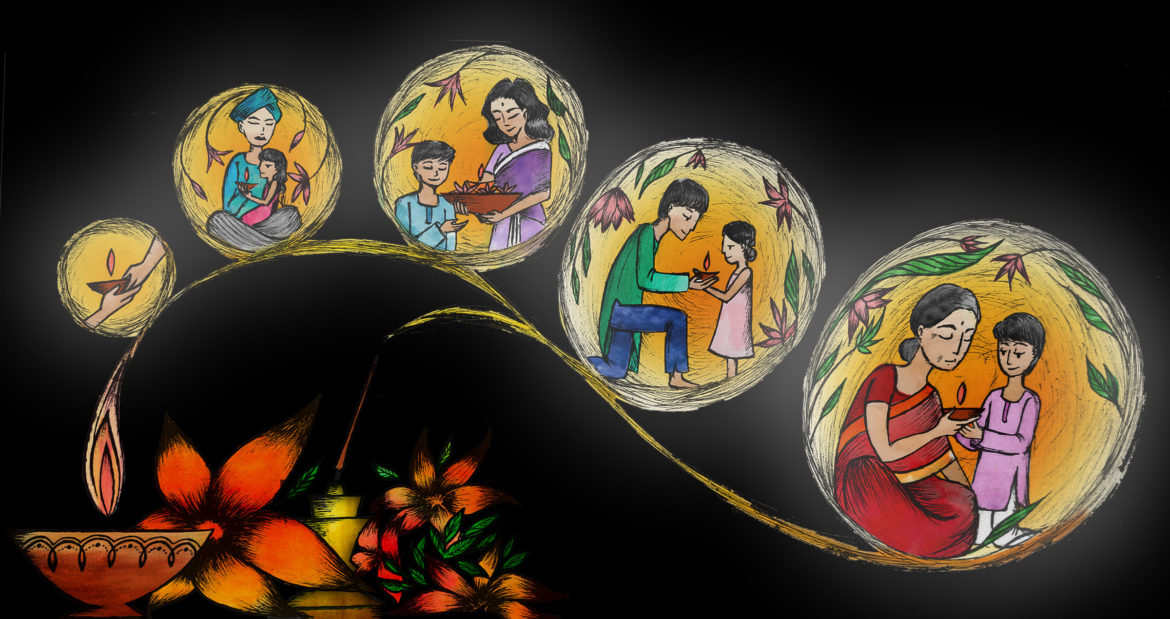January, 2020
In the age of Alternate Facts and Fake News, Fundamatics thought it would be interesting to devote an issue to Folklore and Mythology. This is not an attempt at being flippant but to an honest effort to bring together a collection of diverse stories from various parts of the country. Folklore is how a People imagine their past and themselves. Folk tales become icons of cultures, and in turn, cultures get manufactured around these tales. The tales are told in various art forms – storytelling, singing, theatre, paintings, sculpture and handicraft – and in turn these art forms shape the tales. We are constrained here to limit ourselves to the written word but the written word is no mean instrument – as we shall see* (hum dekhenge ).
Mallika Iyer narrates how mythology was used as an instrument of revolt against the British during the freedom movement. The colonial rulers sought to clamp down on dissent by bringing in the Dramatic Performances Act 1876, which has survived Independence and is being used as in the past – at the whims and fancies of the powers that be. Arnapurna Rath introduces us to Nabagunjara and Patachitra of Odisha and its possible links to Munda tribes and an ecological consciousness. Ganesha and Saraswati, the two deities of Knowledge familiar to all of us, are joined by a third divine being, Hayagriva. Kanakavalli Santhanam tells us the story of ‘two danavas by the name Madhu and Kaitabha, who were embodiments of the qualities of tamas and rajas’, and how they stole the four Vedas. Hayagriva retrieves the Vedas from these danavas and restores them to Brahma so that he can recreate the Universe. A tale of hope for the present, considering that Hayagriva resides in the NorthEast. In Bengal, the retelling of events of Ashura and the martyrdom of Imam Husain has taken the form of folksongs and epics and produced a genre of music and poetry called jungnama. Sreejata Paul gives us a glimpse of the cultural aspect of the mythologies woven around a historical event. Finally, the master story-teller and whisperer of hope, Sherline Pimenta narrates the story of how the Gulmohur tree came to have red blossoms.
An issue devoted to Indian Mythology today would not be complete without input from Devdutt Pattanaik. We are fortunate that he agreed to respond to queries from the editorial team on your behalf. We hope you will find his replies and comments illuminating, as we did.
We are grateful to the authors for their contributions that capture the diversity of folklores in our land. Please let us have your feedback.
CONTENTS
In Conversation with Devdutt Pattanaik BY Queen Bee
Renowned Indian mythologist, speaker, illustrator and author, Devdutt Pattanaik known for his prolific writing on sacred lore, legends and folklore tackles questions from Queenbee.
Ecological Consciousness and the Tale of the Nabagunjara from Folk Odisha BY Arnapurna Rath
Introduces the Nabagunjara and Patachitra of Odisha and its possible links to Munda tribes and an ecological consciousness.
Storytellers: The Tribe of the Hope Whisperers written BY Sherline Pimenta
A mesmerizing story in folklore tradition about how the once pristine white blossoms of the Gulmohar tree took on their red and orange hue.
Mythology’s Hand in History BY Mallika Iyer
Narrates how mythology was used as an instrument of revolt against the British during the freedom movement.
The Afterlives of Karbala in Bengal BY Sreejata Paul
Unearths the lesser-known but the vibrant performative tradition of Karbala narratives that thrived in Bengal during the 19th century.
Hayagriva – The Bestower of Knowledge BY Kanakavalli Santhanam
Tells us the story of two danavas by the name Madhu and Kaitabha, who were the embodiment of the qualities of tamas and rajas’, and how they stole the four Vedas.
- Art for Art’s Sake? - January 14, 2022
- The Tribe of Hope Whisperers - April 9, 2021
- Reimagining a post-COVID World - February 10, 2021
